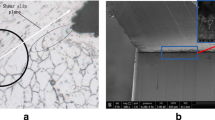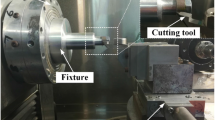Abstract
Mechanical micro-cutting is one of advanced processes to manufacture the miniature parts. The uncut chip thickness is one of the two important parameters in mechanical cutting. The uncut chip thickness and the cutting edge radius are at the same length scale, and the cutting tool extrudes and shears the workpiece with the round cutting edge during micro-cutting process. Size effect of specific cutting energy in micro-cutting is significant in comparison with that in macro cutting. A slip-field model is proposed in this paper to analyze the deformation process of workpiece material in micro-cutting. Johnson–Cook constitutive model, which includes shear strain hardening, shear strain rate hardening, shear temperature softening, and plasticity strain gradient (PSG) effects, is applied to the calculation of the shear flow stress at the primary shear zone (PSZ). Predicted cutting force using the shear flow stress is validated by the micro-orthogonal cutting experiments. The specific cutting energy is also calculated. It shows that the size effect on specific cutting energy in micro-cutting is influenced greatly by the shear strain hardening, shear strain rate hardening, shear temperature softening, and relative cutting length due to the ratio of uncut chip thickness to cutting edge radius. The plasticity strain gradient has effect on the specific cutting energy when the uncut chip thickness is smaller than 25 μm for micro-orthogonal cutting AISI 1045 steel.
Similar content being viewed by others
References
Masuzawa T (2000) State of the art of micromachining. Ann-Manuf Techn 49(2):473–488
Fang FZ, Wu H, Liu XD, Liu YC, Ng ST (2003) Tool geometry study in micromachining. Journal Micromech Microeng 13:726–731
Chen MJ, Ni HB, Wang ZJ, Jiang Y (2012) Research on the modeling of burr formation process in micro-ball end milling operation on Ti–6Al–4 V. Int J Adv Manuf Tech 62(9):901–912
Chae J, Park SS, Freiheit T (2006) Investigation of micro cutting operations. Int J Mach Tool Manu 46(3–4):313–332
Kim JD, Kim DS (1995) Theoretical analysis of micro-cutting characteristics in ultra-precision machining. J Mater Process Tech 49(3–4):387–398
Tamaniau DA, Dautzenberg JH (1991) Bluntness of the tool and process forces in high-precision machining. CIRP Ann-Manuf Techn 40(1):65–68
Abdelmoneim ME, Scrutton RF (1974) Tool edge roundness and stable build-up formation in finishing machining. J Eng for Ind 96(4):1258–1267
Subbiah S, Melkote SN (2008) Effect of finite edge radius on ductile fracture ahead of the cutting tool edge in micro-cutting of Al2024-T3. Mat Sci Eng A-Struct 474(1–2):283–300
Merchant ME (1945) Mechanics of the metal cutting process. II. Plasticity conditions in orthogonal cutting. J Appl Phys 16:318–324
Lee EH, Shaffer BW (1951) The theory of plasticity applied to a problem of machining. J Appl Mech 18:405–413
Oxley PLB (1989) Mechanics of machining–an analytical approach to assessing machinability. Ellis Horwood Limited (UK); 1–135
Altintas Y, Chua CK, Vollertsen F, Yang DY (2012) Preface. J Mater Process Tech 212(3):541
Waldorf DJ, DeVor RE, Kapoor SG (1998) A slip-line field for ploughing during orthogonal cutting. J Manuf Sci E-T. ASME 120(4):693–698
Fang N (2003) Slip-line modeling of machining with a rounded-edge tool—part I: new model and theory. J Mech Phys Solids 51(4):715–742
Fang N (2003) Slip-line modeling of machining with a rounded-edge tool—part II: analysis of the size effect and the shear strain-rate. J Mech Phys Solids 51(4):743–762
Jin X, Altintas Y (2012) Slip-line field model of micro-cutting process with round tool edge effect. J Mater Process Tech 211(3):339–355
Özel T, Zeren E (2005) Finite element method simulation of machining of AISI 1045 steel with a round edge cutting tool. In: Proceedings of the 8th CIRP International Workshop on Modeling of Machining Operations, Chemnitz, Germany 533–542
Childs THC (2006) Numerical experiments on the influence of material and other variables on plane strain continuous chip formation in metal machining. Int J Mech Sci 48(3):307–322
Aramcharoen A, Mativenga PT (2009) Size effect and tool geometry in micromilling of tool steel. Precis Eng 33(4):402–407
Mian AJ, Driver N, Mativenga PT (2011) Identification of factors that dominate size effect in micro-machining. Int J Mach Tools Manuf 51(5):383–394
Polini W, Turchetta S (2004) Force and specific energy in stone cutting by diamond mill. Int J Mach Tools Manuf 44(11):1189–1196
Rodrigues AR, Coelho RT (2007) Influence of the tool edge geometry on specific cutting energy at high-speed cutting. J Braz Mech Sci 29(3):279–283
Lucca DA, Rhorer RL, Komanduri R (1991) Energy dissipation in the ultraprecision machining of copper. CIRP Ann - Manuf Tech 40(1):69–72
Lucca DA, Rhorer RL, Komanduri R (1993) Effect of tool edge geometry on energy dissipation in ultra-precision machining. CIRP Ann - Manuf Tech 42(1):83–86
Shaw MC (2003) The size effect in metal cutting. Sadhana 28(5):875–896
Wu X, Li L, He N, Zhao M, Zhan Z (2015) Investigation on the influence of material microstructure on cutting force and bur formation in the micro cutting of copper. Int J Adv Manuf Tech 79(1):321–327
Atkins AG (2003) Modeling metal cutting using modern ductile fracture mechanics: quantitative explanations for some long standing problems. Int J Mech Sci 45(2):373–396
Karpat Y (2009) Investigation of the effect of cutting tool edge radius on material separation due to ductile fracture in machining. Int J Mech Sci 51(7):541–546
Manjunathaiah J, Endres WJ (2000) A new model and analysis of orthogonal machining with an edge-radiused tool. J Manuf Sci E-T. ASME 122(3):384–390
Liu X, Jun MBG, Devor RE, Kapoor SG (2004) Cutting mechanisms and their influence on dynamic forces, vibrations and stability in micro-end milling. ASME Conference Proceedings 583–592
Adibi-Sedeh AH, Madhavan V, Bahr B (2003) Extension of Oxley’s analysis of machining to use different material models. J Manuf Sci E-T. ASME 125(4):656–666
Filiz S, Conley CM, Wasserman MB, Ozdoganlar OB (2007) An experimental investigation of micro-machinability of copper 101 using tungsten carbide micro-endmills. Int J Mach Tools Manuf 47(7–8):1088–1100
Lai X, Li H, Li C, Lin Z, Ni J (2008) Modeling and analysis of micro scale milling considering size effect, micro cutter edge radius and minimum chip thickness. Int J Mach Tools Manuf 48(1):1–14
Wu J, Liu Z (2010) Modeling of flow stress in orthogonal micro-cutting process based on strain gradient plasticity theory. Int J Adv Manuf Tech 46(1):143–149
Ahn HII, Moon SK, Hwang J (2016) A mechanistic cutting force model with consideration of the intrinsic and geometric size effects decoupled. Int J Adv Manuf Tech 81(5):745–753
Johnson GJ, Cook WH (1983) A constitutive model and data for metals subjected to large strains high strain rates and high temperatures, Proceedings of the 7th International Symposium on Ballistics 541–547
Özel T, Zeren E (2004) Determination of work material flow stress and friction for FEA of machining using orthogonal cutting tests. J Mater Process Tech 153–154:1019–1025
Jaspers SPFC, Dautzenberg JH (2002) Material behavior in conditions similar to metal cutting: flow stress in the primary shear zone. J Mater Process Tech 122(2–3):322–330
Oxley PLB, Hastings WF (1977) Predicting the strain rate in the zone of intense shear in which the chip is formed in machining from the dynamic flow stress properties of the work material and the cutting conditions. Pro Roy Soc A 356(1686):395–410
Loewen EG, Shaw MC (1954) On the analysis of cutting tool temperature. Transaction of. ASME 76:217–231
Nix WD, Gao H (1998) Indentation size effects in crystalline materials: a law for strain gradient plasticity. J Mech Phys Solids 46(3):411–425
Arsenlis A, Parks DM (1999) Crystallographic aspects of geometrically-necessary and statically-stored dislocation density. Acta Mater 47(5):1597–1611
Liu K, Melkote SN (2006) Material strengthening mechanisms and their contribution to size effect in micro-cutting. J Manuf Sci E-T. ASME 128(3):730–738
Liu K, Melkote SN (2007) Finite element analysis of the influence of tool edge radius on size effect in orthogonal micro-cutting process. Int J Mech Sci 49(5):650–660
Duan CZ, Zhang LC (2012) Adiabatic shear banding in AISI 1045 steel during high speed machining: mechanisms of microstructural evolution. Mater Sci Eng A -Struct 532(15):111–119
Joshi SS, Melkote SN (2004) An explanation for the size-effect in machining based on strain gradient plasticity. J Manuf Sci E-T. ASME 126(4):679–684
Asad M, Mabrouki T, Girardin F, Zhang Y, Rigal JF (2011) Towards a physical comprehension of material strengthening factors during macro to micro-scale milling. Mechanics 17(1):97–104
Schmidt J, Tritschler H (2004) Micro cutting of steel. Microsyst Technol 10(3):167–174
Zhong L, Li L, Wu X, He N (2016) Micro cutting of pure tungsten using self-developed polycrystalline diamond slotting tools. Int J Adv Manuf Tech. doi:10.1007/s00170-016-9292-y
Yang K, Liang Y, Zheng K, Bai Q, Chen W (2011) Tool edge radius effect on cutting temperature in micro-end-milling process. Int J Adv Manuf Tech 52(9):905–912
Wissmillera DL, Pfefferkorn FE (2009) Micro end mill tool temperature measurement and prediction. J Manuf Process 11(1):45–53
Author information
Authors and Affiliations
Corresponding author
Rights and permissions
About this article
Cite this article
Zhang, T., Liu, Z., Shi, Z. et al. Investigation on size effect of specific cutting energy in mechanical micro-cutting. Int J Adv Manuf Technol 91, 2621–2633 (2017). https://doi.org/10.1007/s00170-016-9934-0
Received:
Accepted:
Published:
Issue Date:
DOI: https://doi.org/10.1007/s00170-016-9934-0




